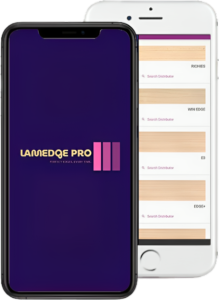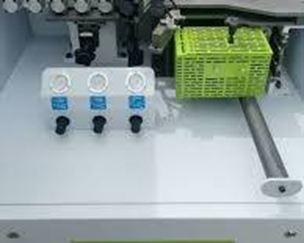Edge banding refers to the process of applying a thin strip of material to the exposed edges of a panel or board, typically used in woodworking and furniture manufacturing. This strip, known as edge banding, serves both functional and aesthetic purposes. It not only conceals the exposed edges of the board but also enhances the overall appearance of the finished product.
An “edge banding finder” could potentially be a tool, device, or software designed to assist professionals in identifying or selecting the appropriate edge banding materials for their specific projects. Such a tool might take into account factors such as material type, colour, texture, and size to help users find the ideal edge banding solution for their particular application.
In an industrial or manufacturing context, an edge banding finder might be integrated into software used by designers, carpenters, or manufacturers. It could streamline the process of choosing edge banding materials by providing a catalos, search functionality, or even augmented reality features to visualize how different edge banding options would look on a finished product.
Edge banding is a process in woodworking where a thin strip of material (often PVC, ABS, wood, or metal) is applied to the exposed edges of a panel or board to give it a finished appearance. This is commonly done to conceal the raw edges of plywood, particleboard, or MDF and to protect the edges from damage.
Features of an "Edge Banding Finder" Tool
- Material Compatibility Database: An edge banding finder could have a database of various edge banding materials, including information on their composition, colors, textures, and sizes.
- Matching System: The tool might include a feature that helps users find the closest match for their specific panel or board, ensuring a seamless and aesthetically pleasing appearance.
- Compatibility with Wood Types: If the tool is advanced, it might consider the type of wood or material being used and recommend edge banding materials that work well with it in terms of adhesion and visual appeal.
- Color Matching Technology: Advanced tools could use color-matching technology to suggest edge banding options that closely match the color of the panel or board.
- User Input and Preferences: The tool might allow users to input their preferences, such as desired thickness, material type, or specific features, to tailor the recommendations to their needs.
How It Might Work
Finder tool would likely involve the following steps:
Input Information: Users input details about their project, such as the type of material, color, thickness, and any specific requirements they have.
Database Search: The tool searches its database for edge banding materials that match the specified criteria.
Recommendations: Based on the search, the tool provides a list of recommended edge banding materials, possibly with images and detailed information.
Visual Simulation: Some tools might even provide a visual simulation, allowing users to see how the selected edge banding would look on their project.
Types of edge banding materials
Wood Veneer Edge Banding:
Thin strips of real wood veneer, available in various wood species.
Applied using heat-sensitive adhesive or glue.
PVC Edge Banding:
Made of polyvinyl chloride (PVC).
Comes in various colors and patterns.
Applied with hot melt adhesives.
ABS Edge Banding:
Acrylonitrile Butadiene Styrene (ABS) material.
Durable and impact-resistant.
Applied using hot melt adhesives.
Melamine Edge Banding:
Matches the appearance of melamine or laminate surfaces.
Applied using hot melt adhesives.
Metal Edge Banding:
Aluminum or other metal strips used for a decorative or protective edge.
Applied using adhesives or mechanical fasteners.
Hot Air Edge Banding:
Involves the use of hot air to activate the adhesive on edge banding.
Tools include hot air edge banding machines.
Edge Banding Machines:
Various types of machines designed for applying edge banding efficiently.
Manual, semi-automatic, and automatic machines are available.
Edge Banding Trimmers:
Handheld tools or attachments for removing excess edge banding material.
Manual or electric trimmers are common.
How to Choose the Right Edge Banding Finder for Your Needs
Manual: These involve manually measuring and marking the placement of the edge banding on your workpiece. They come in various forms, such as squares, T-rules, and marking knives.
Automatic: These utilize mechanisms to automatically determine the edge banding position based on the thickness of your material. They offer greater accuracy and convenience compared to manual options.
Factors to Consider
- Material Thickness: Ensure the finder can accommodate the thickness of your workpiece. Some finders have fixed settings, while others offer adjustable dials for versatility.
- Edge Banding Thickness: Choose a finder compatible with the thickness of your edge banding. Thicker banding may require adjustments or a dedicated finder.
- Application Method: Consider how you’ll be applying the edge banding. Hot melt glue application might require a heat-resistant finder, while pre-glued banding may necessitate a different approach.
- Budget: Manual finders are generally more affordable, while automatic options can be pricier. Consider your needs and frequency of use to determine the best value.
- Accuracy and Ease of Use: Prioritize finders that offer precise measurements and are easy to operate, especially for beginners. Look for features like clear markings, non-slip grips, and adjustable settings.
Tips for Using an Edge Banding Finder
Align the finder: Place the finder against the edge of your project, making sure the edge banding rests in the designated groove. Most finders have markings or guides to help you position it correctly.
Mark your cuts: Use the finder’s marking mechanism to score the edge banding where it needs to be cut to fit your project’s dimensions. Some finders have built-in blades for this purpose, while others require a separate tool.
Cut the edge banding: Use a sharp utility knife or other cutting tool to follow the scored lines and cut the edge banding to the correct length. Be careful not to cut into your project material.
Apply the edge banding: Apply adhesive to the back of the edge banding according to the manufacturer’s instructions. Then, position the edge banding against the scored line on your project and press firmly to adhere it.
Mistakes to Avoid When Using an Edge Banding Finder
- Not using the right type of finder for the job. There are different types of edge banding finders available, each designed for a specific purpose. For example, some finders are better suited for thin materials, while others are better for thicker materials. Using the wrong type of finder can lead to inaccurate measurements and a poor-fitting edge band.
- Not taking into account the thickness of the edge banding. When using an edge banding finder, it’s important to take into account the thickness of the edge banding you’ll be using. Some finders have a built-in adjustment for edge banding thickness, while others require you to manually adjust the measurement. If you don’t take the thickness of the edge banding into account, you’ll end up with an edge band that is either too small or too large.
- Not marking the cut line accurately. Once you’ve used the edge banding finder to measure the distance from the edge of the panel to the groove, it’s important to mark the cut line accurately. Use a sharp pencil or a scoring tool to make a light mark on the panel. If you don’t mark the cut line accurately, you’ll end up with an uneven edge band.
- Cutting the edge banding too short. It’s always better to err on the side of caution and cut the edge banding a little bit longer than you think you need. You can always trim it down to size later, but if it’s too short, you’ll have to start over.
- Not applying the edge banding correctly. Once you’ve cut the edge banding to size, it’s time to apply it to the panel. There are a few different ways to do this, but the most common method is to use a heat gun. Be careful not to apply too much heat, as this can melt the edge banding or damage the panel.
- Not trimming the excess edge banding. Once the edge banding is applied, you’ll need to trim off the excess. Use a sharp utility knife to carefully trim the edge banding flush with the surface of the panel.
- Not cleaning up the edges. After you’ve trimmed the edge banding, be sure to clean up any glue or debris that may have gotten on the panel. Use a damp cloth to wipe down the edges and remove any residue.
Now let's make beautiful furniture for home with the help of Lamedge pro

Introducing Lamedge Pro, Explore over 5,00,000 matching results with Youva! Easily find the perfect PVC edge banding tape for your laminates in just two clicks. Get the best match from top brands and find the nearest distributor’s info, including phone numbers, addresses, and locations. It’s design simplicity at your fingertips!
LameEdge Pro revolutionizes the user experience by offering a mobile-friendly and efficient platform Best Solution for Top laminate brands in india, a key element in empowering users. Through a user-friendly interface, individuals can effortlessly explore a diverse range of PVC edge banding tapes with just a few clicks. This accessibility is particularly advantageous in dynamic industries like manufacturing and design, where the ability to make swift and informed decisions is paramount.
Functioning as a personalized guide for Merino Laminate customers, LameEdge Pro streamlines the process of finding the ideal PVC edge banding tape to complement Merino’s extensive array of laminate products. The application’s database is meticulously crafted to align with Merino’s color schemes, patterns, and textures, ensuring a seamless transition between edge banding and various Merino laminate types. This tailored approach not only facilitates a cohesive aesthetic in the final product but also optimizes time efficiency in the decision-making process.

